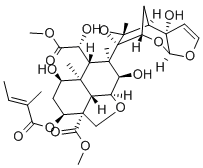Chemical Properties
Off-white, yellowish powder or dark brown
emulsifiable concentrate.
Potential Exposure
Biological tetranortriterpinoid insecticide;
insect growth regulator. A natural product extracted
from seeds of the Neem tree (Azadirachta indica).
First aid
Eyes: First check the victim for contact lenses
and remove if present. Flush victim’s eyes with water or
normal saline solution for 20 to 30 minutes while simultaneously
calling a hospital or poison control center. Do not
put any ointments, oils, or medication in the victim’s eyes
without specific instructions from a physician. Immediately
transport the victim after flushing eyes to a hospital even if
no symptoms (such as redness or irritation) develop. Skin:
Immediately flood affected skin with water while removing
and isolating all contaminated clothing. Gently wash all
affected skin areas thoroughly with soap and water. If
symptoms such as redness or irritation develop, immediately
call a physician and be prepared to transport the victim
to a hospital for treatment. Inhalation: Immediately
leave the contaminated area; take deep breaths of fresh air.
If symptoms (such as wheezing, coughing, shortness of
Azadirachtin 327
breath, or burning in the mouth, throat, or chest) develop,
call a physician and be prepared to transport the victim to a
hospital. Provide proper respiratory protection to rescuers
entering an unknown atmosphere. Whenever possible,
SCBA (SCBA) should be used; if not available, use a level
of protection greater than or equal to that advised under
Protective Clothing. Ingestion: Do Not induce vomiting.
If the victim is conscious and not convulsing, give 1 or 2
glasses of water to dilute the chemical and immediately
call a hospital or poison control center. Be prepared to
transport the victim to a hospital if advised by a physician.
If the victim is convulsing or unconscious, do not give anything
by mouth, ensure that the victim’s airway is open and
lay the victim on his/her side with the head lower than the
body. Do Not induce vomiting. Immediately transport the
victim to a hospital.
Shipping
UN3077 Environmentally hazardous substances,
solid, n.o.s., Hazard class: 9; Labels: 9-Miscellaneous hazardous
material, Technical Name Required.
Incompatibilities
Powder or liquid may form explosive
mixture with air. Incompatible with oxidizers (chlorates,
nitrates, peroxides, permanganates, perchlorates, chlorine,
bromine, fluorine, etc.); contact may cause fires or explosions.
Keep away from alkaline materials, strong bases,
strong acids, oxoacids, epoxides, reducing agents and
metals, acid chlorides, alkalis, alkali metals, high heat,
including sunlight.
Waste Disposal
Waste product may be disposed
of onsite (open dumping may be prohibited) or at an
approved waste disposal facility. All federal, state, and
local environmental regulations must be observed.

